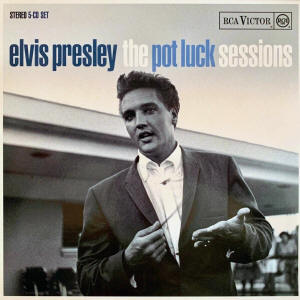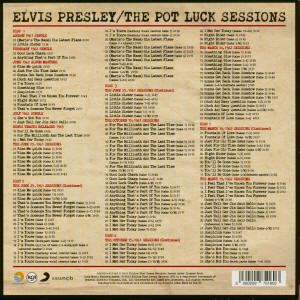(C) Follow That Dream Records / Sony Music Entertainment
In early 1962 RCA's Studio B in Nashville was booked for another two nights of recording. On March 18th and 19th the goal was to tape material for at least one 45 as well as several cuts to fill a future longplayer.
Something Blue (takes 1-7)
The intro mirrors Felix Mendelssohn Bartholdy's "Hochzeitsmarsch", compared to the released version everything sounds rather clumsy. Besides that it sounds as if the singer has chosen the wrong key. Elvis is noticably irritated and even stops to sing for a while. However, he decides to continue the performance and so take number one is a complete presentation of "Something Blue". Before taping another walkthrough, the intro is changed. After a false start another complete rendition is archived, even though the king gets lost in the lyrics in-between. Take 3 is nothing more than two short false starts (Elvis doesn't even get to sing), but the 4th one works out well and already sounds similar to the master. The next try is killed off by the producer. When the king starts to sing "Something old, the times..." he is interrupted by Steve Sholes saying "cut". Elvis turns it into a joke and continues to sing "...the times are cut". The next two takes are complete and very good performances. Realizing, that he cannot improve the result the king settles for take number 7 and moves on to the next item on his agenda.
Gonna Get Back Home Somehow (takes 1-7)Here the arrangement is set right from the start and nobody appears to be challenged by the song. The first walkthrough sounds very good, there are just a few details to be ironed out. During the second take Elvis tries to add Millie Kirkham's soprano voice, but it rather sounds distracting. So take 3 once again has to do without the addition. First the king misses his cue, afterwards he stops to sing after a short while. Take number 4 once again works very well and even is stored as "alternate master". Nevertheless Elvis is keen to improve his performance and tapes another three versions. The 7th take is preceded by a false start, but what follows is good enough to be approved for release.
(Such An) Easy Question (takes 1-5)Elvis satirizes a pilot's announcement before starting the plane, then he focuses on take number one. However, he kills it off before the intro is over because the tempo is too fast. The second try is a complete performance, but now the king has to realize, that the song drags a bit if played according to his wishes. As a result, he stops the intro of take 3 to raise the tempo. Another complete rendition follows and by now everything sounds quite good. Take number 4 is just a short false start, number 5 turns out to be the master.
Fountain Of Love (takes 1-10)Take 1 is canceled by Elvis because he doesn't like the intro. The second try is a complete rendition, but the arrangement isn't in place yet. The tempo is slower and the harmony singers perform differently. Somehow the flow of the master is missing. Elvis also has trouble to phrase "We live in a fountain of love", which he repeates over and over again to give the engineer time for a fade-out. During take number 3 the choir messes up the intro, afterwards its tried to start the song without the vocals. Now the guitarist doesn't get it right, but it's decided that it sounds better without the singers. Take 4 starts with another messed up intro, later Elvis stumbles upon the word "should" and ends the procedure. The next try doesn't get too far, in the background someone can be heared saying "I like the intro". Before another take is put on tape, the arrangement is changed. The harmony singers don't repeat the words "fountain of love", which leads to a better flow. The new intro is kept, too. With the new composition in place Elvis and the group can focus on the details. After a complete performance (take 6) the following attempt doesn't make it past the intro. The next try is canceled just as quickly, this time by the engineer. Takes number 9 and 10 are two more complete performances with the final one being approved for release.
Just For Ol' Times Sake (takes 1-5)Here the arrangement is set right from the start and the ballad doesn't challenge anyone. However, at the second try Elvis sings it wrong and when he starts again the take is killed off by the producer. Take number 3 finds the king stumbling over the word "relive", which ends the procedure. After another false start Elvis and the group manage to present a complete performance. The 5th take works right from the start and is chosen as master.
Night Rider (re-recording: takes 1-5)Since Elvis isn't happy with his recording of "Night Rider" he uses the session to try again. The engineer switched on the machine in the midst of a jam. It's a pity, that we only get to hear the final part of it. Take number one is killed off by the king, because he misses his cue at the line "When you think it is the breeze...". Once again the musicians start a jazzy jam, which obviously amuses Mr. Sholes as he announces the next take. However, it's a short one since Elvis just sings the song title twice before he stops. Take 3 is a complete performance.The next attempt is just a false start, because the king misses his cue. With take number 5 Elvis and the band deliver a second complete rendition, which is selected for release. Later he would reconsider his decision and settle for his original recording.
You'll Be Gone (takes 1-4)Once again the arrangement is set right from the start and nobody has any trouble to perform the song. All four takes are complete performances, which differ just slightly. Before the final attempt there is a short false start. Elvis choses the 3rd take for release, but Steve Sholes (maybe because he doesn't agree with his star) files take 4 as "alternate master".

